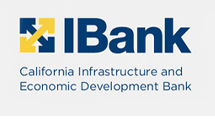SANTA ANA, Calif. – A Southern California ocean tech startup was able to expand its manufacturing capacity in 2024 and ride a production wave toward increased sales thanks to a specialized state guarantee program that resulted in a $1 million loan.
Vista-based Seatrec, which developed its first underwater robot, the infiniTE™ Float, used the $1 million loan from American Lending Center (ALC) to expand its San Diego facility by 1,000 square feet, creating a dedicated clean manufacturing space outfitted with new equipment, resulting in a 10-fold increase in production capacity in 2025. The capital is backed by an 80% guarantee from the State Small Business Credit Initiative throughCalifornia’s six-year-old Climate Tech Finance program and administered by the Small Business Development Corporation of Orange County (SBDC-OC).
The Seatrec guarantee is the first Climate Tech deal handled by SBDC-OC, one of seven development corporations around the state, and represents a first state loan guarantee deal for American Lending Center.
Climate Tech Finance is a unique partnership established in 2018 between the Bay Area Air Quality Management District and the California Infrastructure and Economic Development Bank, or IBank for the purpose of bolstering development of greenhouse gas-reducing technologies and clean industry in California.
Both Climate Tech and SBDC-OC operate under IBank which offers loan guarantee programs and initiatives for small businesses and entrepreneurs, particularly those operating outside of the economic mainstream.
The increased space and new machinery reduced the usual months-long assembly process and Seatrec anticipates pushing out up to 100 units in 2025 compared to 10 units produced in 2024. It is a significant turning point for a startup that previously struggled to land conventional funding due to lack of a sales track record and sets the stage for Seatrec to raise Series A capital from investors during 2025 toward expanding the business side of its team and its product line.
“I think this loan guarantee kind of breaks that cycle. It is a critical type of loan guarantee.”
“If I walk into the bank, they will say, ‘no way, I can’t give you a loan because you don't have a sales record,’” said Dr. Yi Chao, Seatrec’s chief executive officer, founder and a former scientist with NASA’s Jet Propulsion Laboratory. “Also, very few government programs support manufacturing for an early stage startup. We are not big enough. The only way to scale up is through sales and then through private capital. Series-A investors look for sales to reduce their risks. But if you don't have a manufacturing facility, how to generate more sales? It's like a chicken-and-egg problem. I think this loan guarantee kind of breaks that cycle. It is a critical type of loan guarantee,” Chao said.
In 2016, Chao launched Seatrec with licensed technology for a prototype he developed in collaboration with co-inventors, Jack Jones and Thomas Valdez. He spun the company out of CalTech in Pasadena, which manages JPL on behalf of NASA, after a successful career as a scientist for over two decades.
Using patented technology, Seatrec’s underwater robots harness energy from temperature differences in the ocean (warm at the surface and cold at depths) to provide renewable, clean electricity for powering oceanographic sensors. The current state-of-the-art underwater floats are powered by primary batteries which, once depleted, are left behind to litter the sea floor. To rent a ship that operates in the open ocean is expensive -- $50,000 or more per day – that it is simply cheaper to buy a new float than to recover the float for battery replacement or recharging.
A photo demonstrating the Seatrec infiniTE™ float. (Courtesy of Seatrec)
Seatrec’s infiniTE™ float is designed to carry sensors created to detect various types of data in the ocean. The infiniTE™ float is free-drifting, following the ocean currents. It can dive down as dep as 1,000 meters, or about 3,280 feet. During the vertical dive, the sensor collects data along the way in what is known as a vertical profile of the water it passes through – data could include water temperature, water salinity, oxygen and acidity levels used for analysis by researchers, warming rates in relation to climate change, or sounds of whales and other marine mammals and military target detection in soundscape profiles, and mapping of the ocean floor and ocean depth, among other things.
“We provide a cost-effective robot that can be deployed in large quantities, thousands if not millions, on the global scale,” Chao said regarding Seatrec’s seabed mapping capabilities and the need for further seabed exploration – only 25% of the seabed has been charted.
Seatrec’s technology is being used by academic researchers and non-governmental organizations engaged in ocean exploration, by government laboratories for technology, defense and military applications, and by commercial offshore industries including shipping and renewable energy sectors.
The Seatrec floats can also help meteorologists determine the strength and longevity of hurricanes by measuring the depth of warm ocean water where hurricanes originate. Currently, scientists know hurricanes intensify over warmer waters. However, scientists do not know how deep the warmer waters extend, a measure of the potential energy available to fuel the hurricane intensification. “By knowing that depth of these warmer waters, scientists will be able to forecast how rapidly hurricanes would intensify,” Chao said.
Seatrec deployed a pilot infiniTE™ float and sensors from a fishing boat off the coast of Destin, Florida a week before Hurricane Helene in September 2024 to collect data every six hours. Helene evolved into an immense Category 4 storm which killed 238 people and fairly quickly turned inland. The data Seatrec was able to collect is being analyzed by scientists at a NOAA research lab in Miami. The goal is to deploy a fleet infiniTE floats in the Gulf of Mexico before the next hurricane season to measure the temperature of the warm gulf waters at various depths so that data can be provided in real time to NOAA to improve hurricane predictions, Chao said.
Chao grew up in China where he earned a bachelor’s degree in physics from the University of Science and Technology. He came to the U.S. for graduate school at Princeton University where he earned a master’s degree in geophysical fluid dynamics and a Ph.D. in atmospheric and ocean sciences.
“I always like math and physics, and then try to apply that knowledge to a real-world problem,” Chao said. “Atmospheric sciences was the first applied problem, and then oceanography intrigued me the most because we know so little about the ocean.”
While JPL is popularly known for its exploration of Mars, it is also engaged in astrophysics, planetary science and earth science, Chao said, the latter of which comprises about a quarter of JPL’s research through monitoring and analysis of the atmosphere, oceans, ice and earthquakes.
Chao worked for 20 years in the Ocean Division at JPL using computers and satellites to study the ocean of the ocean. However, satellite-based ocean exploration is limited to the water’s surface and does not penetrate into the deep sea. “That's how I got to underwater robotics, to see how to develop a robotic system that can dive and stay in the ocean for a long time. That's kind of what motivated Seatrec from the early days, to develop this energy-harvesting technology to solve the biggest bottleneck in underwater robotics, how to power them when the battery runs out,” he said.
In late 2023, Climate Tech Finance corroborated Seatrec’s subsea robotic power technology and its clean environmental impact for the purposes of SBDC-OC’s loan guarantee assessment process.
“We are thrilled to be able to help Seatrec move forward and broaden its impressive technology,” said SBDC-OC President Jim Ely who facilitated the Seatrec’s guarantee deal through Climate Tech Finance. “It is inspiring to know that the company assisted by our efforts is making inroads in oceanic research and sea-based industrial activities, and that our work will also have an economic impact through sustaining and creating jobs.”
Said Michael Ocasio, SBDC-OC’s chief executive officer, “We are excited to fulfill our first Climate Tech Finance transaction. This program is a game-changer and holds much potential to help scientist entrepreneurs further develop inventions that will increase our quality of life, and we look forward to being a part of the process as they pursue success.”
American Lending Center, a private lender based in Irvine, has a strong partnership with SBDC-OC, offering both federal and state financing programs. Larry Trujillo, senior advisor at ALC and board member at SBDC-OC, highlighted the shared values and mission of both organizations in supporting disadvantaged business owners. He also emphasized the economic advantages of the loan, with ALC's investment secured by the 80% guarantee.
"Participating in Climate Tech Finance opens doors for lenders to invest in promising clean tech companies early on," Trujillo said. "This program allows us to support innovative businesses that might otherwise be considered too risky."
(For additional articles and information about SBDC-OC’s fiscal year 2023 results click here.)







